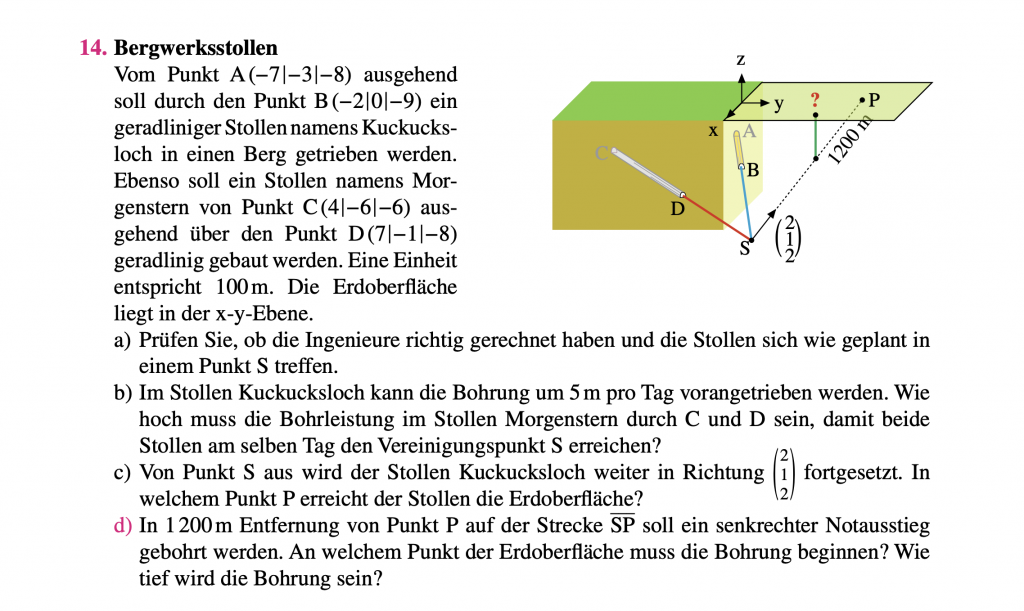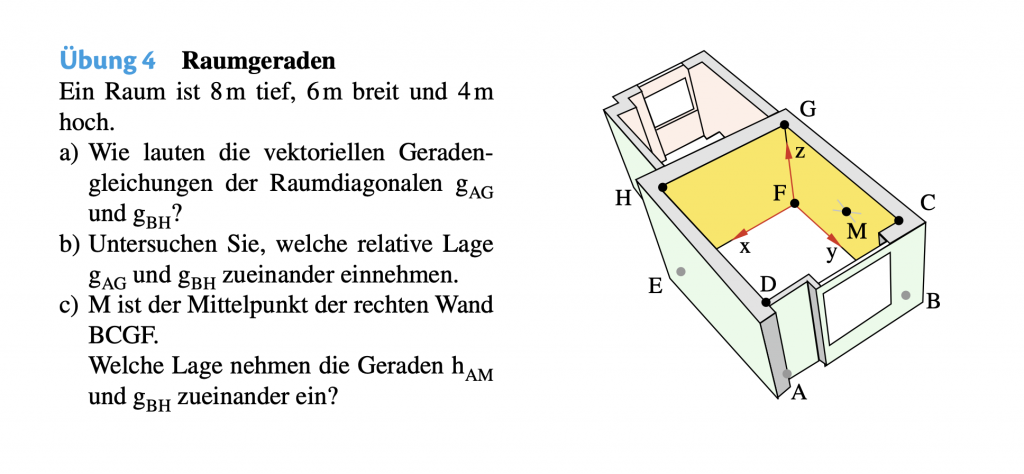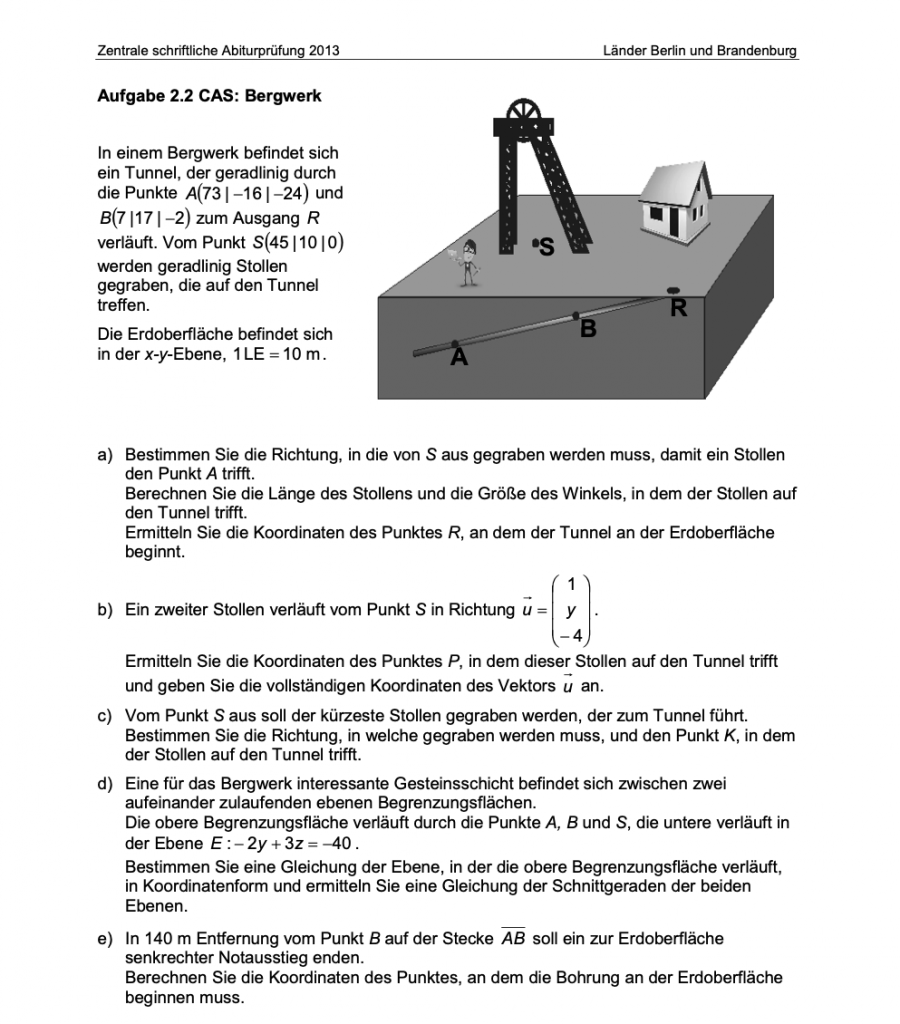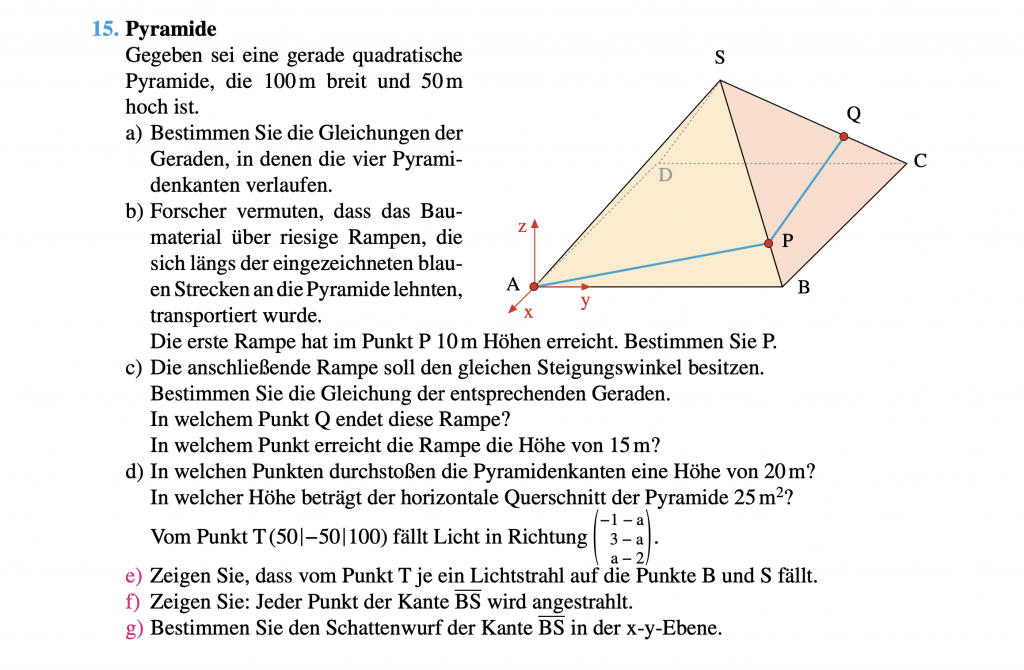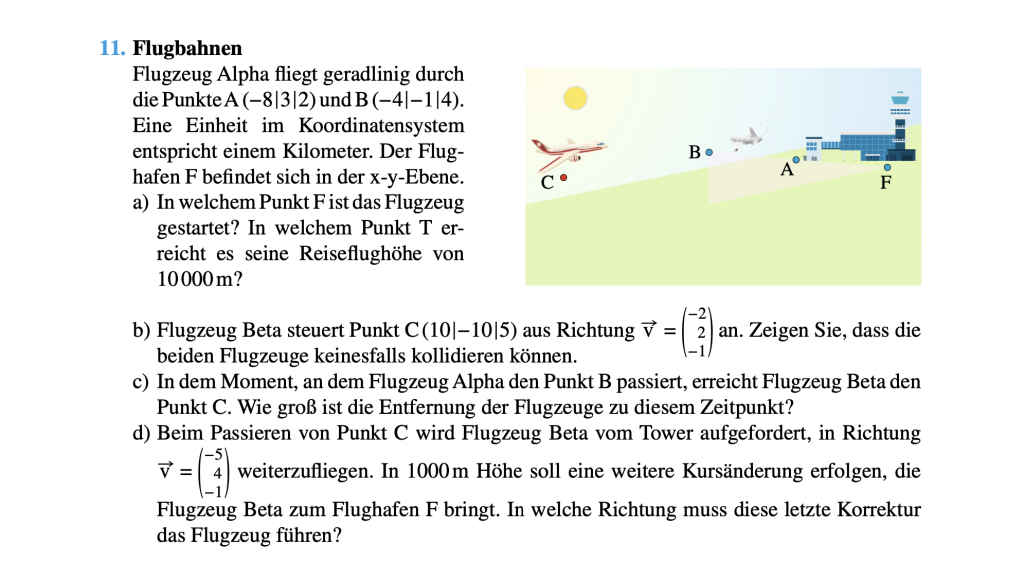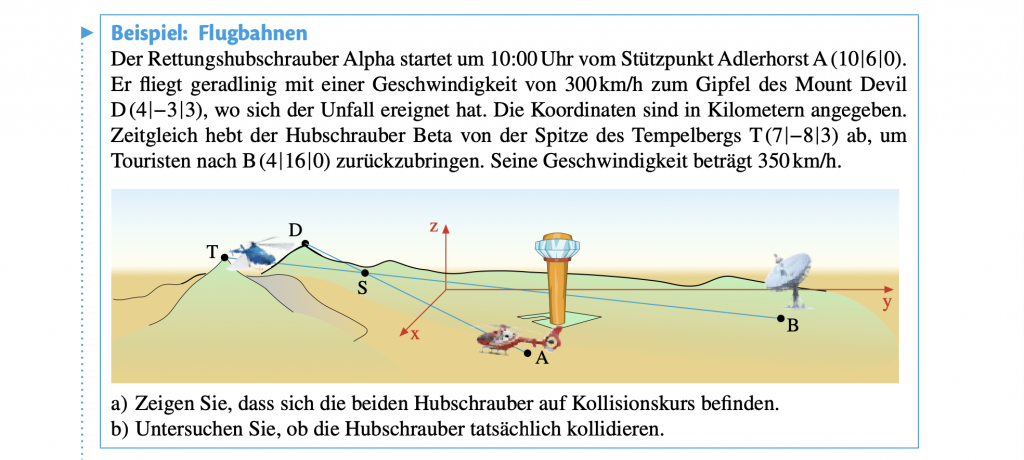Home » Mathematik » Lagerbeziehung
Category Archives: Lagerbeziehung
Übungen Geometrie - Vektorrechnung
Übungsaufgaben
-
Gegeben sind die drei Punkte $A(3|5|1)$, $\: B(-5|7|17)$, und $C(6|2|13)$
a) Gebe eine Gerade der Gleichung an, die durch die Punkte $A$ und $B$ geht. Zeige, dass der Punkt $M(-1|6|9)$ der Mittelpunkt der Strecke $AB$ ist.
b) Weise nach, dass das Dreieck $AMC$ rechtwinklig ist.
Gebe den Flächeninhalt des Dreiecks $ABC$ an.
Lösung$A(3|5|1)$, $\: B(-5|7|17)$, und $C(6|2|13)$
$\:\:$ a) Gebe die Gerade $g$ durch $A$ und $B$.
$\qquad\qquad g_{AB}:\vec{x}= \begin{pmatrix} 3\\5\\1 \end{pmatrix} + r\cdot \begin{pmatrix} -5-3\\7-5\\17-1 \end{pmatrix} = \begin{pmatrix} -8\\2\\16 \end{pmatrix} $
$ \:\:\: $ $ \: \Large \Bigg\downarrow $ $ \normalsize Zeige,\: dass\: M\: der\: Mittelpunkt\: von\: AB\: ist $
$\qquad$ $x_M= \frac{1}{2} (3-5)=-1 \:\:|\:\: y_M= \frac{1}{2} (5+7)=6 \:\:|\:\: z_M= \frac{1}{2} (1+17)=9 $
$\qquad$ $ \longrightarrow \: M \begin{pmatrix} -1\\6\\9 \end{pmatrix}, \:\: $ mit $ r=\frac{1}{2} $
$\:\:$ b) Weise nach, dass das Dreieck $AMC$ rechtwinklig ist.
$\qquad$ Berechne $\overrightarrow{AM}$ und $\overrightarrow{MC}$
$\qquad\qquad$ $ \overrightarrow{AM}= \begin{pmatrix} -1-3\\6-5\\9-1 \end{pmatrix} = \begin{pmatrix} -4\\1\\8 \end{pmatrix} $ $ \:\:|\:\: $ $ \overrightarrow{MC}= \begin{pmatrix} 6+1\\2-6\\13-9 \end{pmatrix} = \begin{pmatrix} 7\\-4\\4 \end{pmatrix} $
$\qquad$ Berechne das Skalarprodukt von $\overrightarrow{AM}$ und $\overrightarrow{MC}$
$\qquad\qquad$ $ \overrightarrow{AM} \cdot \overrightarrow{MC} = -4\cdot7+1\cdot (-4)+8\cdot 4=0 \:\: \longrightarrow \:\: AMC $ ist rechtwinklig.
$\qquad$ Gebe den Flächeninhalt des Dreiecks $ABC$ an.
$\qquad\qquad$ Betrag von $AM$: $ | \overrightarrow{AM} |= \sqrt{(-4)^2+1^2+8^2}=9 $
$\qquad\qquad$ Betrag von $MC$: $ | \overrightarrow{AM} |= \sqrt{7^2+(-4)^2+4^2}=9 $
$\qquad\qquad$ Betrag von $AB$: $ | \overrightarrow{AB} |= 2\cdot | \overrightarrow{AM} |= 2\cdot 9= 18 $
$\qquad\qquad$ Flächeninhalt von $ABC=9\cdot 9=81\:FE$ -
Die Gerade
$
g:\vec{x}
=
\begin{pmatrix}
0\\0\\12
\end{pmatrix}
+r\cdot
\begin{pmatrix}
1\\0\\-3
\end{pmatrix};
\:
r\in\mathbb{R}
$
und der Punkt $B(0|3|6)$ legen eine Ebene $E$ fest.
a) Weise nach, dass $3x+2y+z=12$ eine Gleichung für die Ebene $E$ ist.
b) Die Ebene $E$ schneidet die $x$-$y$-Ebene. Gebe die Koordinaten von zwei Punkten an, die auf der Schnittgeraden der Ebene $E$ mit der $x$-$y$-Ebene liegen.
Lösung$ g:\vec{x} = \begin{pmatrix} 0\\0\\12 \end{pmatrix} +r\cdot \begin{pmatrix} 1\\0\\-3 \end{pmatrix} $ und $B(0|3|6)$
a) Weise nach, dass $3x+2y+z=12$ eine Gleichung für die Ebene $E$ ist.
$ \:\:\: $ $ \: \Large \Bigg\downarrow $ $ \normalsize Setze\: g\: und\: B\: in\: E\: ein\: und\: prüfe\: ob\: 12\: raus\: kommt $
$\qquad$ $ *\:\: 3(0+r)+2(0+0r)+(12-3r)=12 $
$\qquad$ $ \:\: \iff 3r+12-3=12 $
$\qquad$ $ \:\: \iff 12=12\:\: W.A.\:\: \longrightarrow\:\: $ $g$ liegt auf $E$.
$\qquad$ $ *\:\: 3(0)+2(3)+6=12 $
$\qquad$ $ \:\: \iff 12=12\:\: W.A.\:\: \longrightarrow\:\: $ $B$ liegt auf $E$.
b) Koordinaten von Punkten, die auf der Schnittgeraden der Ebene $E$ mit der $x$-$y$-Ebene liegen.
$ \:\:\: $ $ \: \Large \Bigg\downarrow $ $ \normalsize Gebe\: die\: Koordinaten\: von\: 2\: Punkten\: an $
$\qquad$ Schnittpunkt mit $x$-$y$-Ebene $\longrightarrow$ $z=0$
$\qquad$ Seien: $ P \begin{pmatrix} x_P\\y_P\\z_P \end{pmatrix} = \begin{pmatrix} x_P\\y_P\\0 \end{pmatrix} $ $ \:\:\: $ und $ \:\:\: $ $ Q \begin{pmatrix} x_Q\\y_Q\\z_Q \end{pmatrix} = \begin{pmatrix} x_Q\\y_Q\\0 \end{pmatrix} $
$\qquad$ $P$ hat einen Schnittpunkt mit $E$:
$\qquad$ $\Longrightarrow 3 \cdot x_P+2 \cdot y_P+0 \cdot z_P=12 $
$\qquad$ Für $x_P=0, \:\:\:3\cdot 0+2\cdot y_P+0\cdot z_P=12 $
$\qquad\qquad$ $ \iff 2\cdot y_P=12 $
$\qquad\qquad$ $ \iff y_P=6 $ $ \longrightarrow P \begin{pmatrix} 0\\2\cdot 6\\0 \end{pmatrix} = \begin{pmatrix} 0\\6\\0 \end{pmatrix} $
$\qquad$ $Q$ hat einen Schnittpunkt mit $E$:
$\qquad$ $\Longrightarrow 3 \cdot x_Q+2 \cdot y_Q+0 \cdot z_Q=12 $
$\qquad$ Für $y_Q=0, \:\:\:3\cdot x_Q+2\cdot 0+0\cdot z_Q=12 $
$\qquad\qquad$ $ \iff 3\cdot x_Q=12 $
$\qquad\qquad$ $ \iff x_Q=4 $ $ \longrightarrow Q \begin{pmatrix} 3\cdot 4\\0\\0 \end{pmatrix} = \begin{pmatrix} 4\\0\\0 \end{pmatrix} $
$\qquad$ Da bekommst du die Punkte $ P \begin{pmatrix} 0\\6\\0 \end{pmatrix} \:\: $ und $ \:\: Q \begin{pmatrix} 4\\0\\0 \end{pmatrix} $ -
Lösung$A(6|0|0), \: B(0|8|0), \: C(6|8|0)$ und $S(0|0|10)$
a) Gebe eine Gleichung der Geraden an, die durch die Punkte $S$ und $C$ geht.
$ \:\:\: $ $ \: \Large \Bigg\downarrow $ $ \normalsize Setze\: S\: als\: Ortsvektor \:(Stützvektor) $
$\qquad$ $ g_{SC}: \vec{x}= \begin{pmatrix} 0\\0\\10 \end{pmatrix} +r\cdot \begin{pmatrix} 6\\8\\-10 \end{pmatrix} $
$ \:\:\: $ $ \: \Large \Bigg\downarrow $ $ \normalsize Zeige\: dass\: M\: der\: Mittelpunkt\: von\: SC\: ist $
$\qquad$ $ x_{SC}= \frac{0+6}{2}=3\:\:|\:\: y_{SC}= \frac{0+8}{2}=4\:\:|\:\: z_{SC}= \frac{10+0}{2}=5\ $ $ \iff M(3|4|5) $
b) Weise nach, dass das Dreieck $ABM$ ein rechtwinkliges Dreieck ist.
$\qquad$ Berechne $\overrightarrow{AM}$ und $\overrightarrow{AB}$
$\qquad\qquad$ $ \overrightarrow{AM}= \begin{pmatrix} 3-6\\4-0\\5-0 \end{pmatrix} = \begin{pmatrix} -3\\4\\5 \end{pmatrix} $ $ \:\:|\:\: $ $ \overrightarrow{MB}= \begin{pmatrix} 3-0\\4-8\\5-0 \end{pmatrix} = \begin{pmatrix} 3\\-4\\5 \end{pmatrix} $
$\qquad$ Berechne das Skalarprodukt von $\overrightarrow{AM}$ und $\overrightarrow{MB}$
$\qquad\qquad$ $ \overrightarrow{AM} \cdot \overrightarrow{MB} = -3\cdot3+4\cdot (-4)+5\cdot 5=0 $
$\qquad\qquad$ $ \longrightarrow \:\: $ AMB ist rechtwinklig, bei $M$. -
Gegeben ist die Ebene $E$ durch $E:3x-4y+z=11$ und die Gerade $g$ durch
$
g:\vec{x}=
\begin{pmatrix}
2\\0\\5
\end{pmatrix}
+r\cdot
\begin{pmatrix}
3\\2\\-1
\end{pmatrix};
\:\:
r\in\mathbb{R}.
$
$\:\:$ a) Zeige, dass die Gerade $g$ in der Ebene $E$ liegt.
$\:\:$ b) Ermittle eine Gleichung für eine Gerade $h$, die ebenfalls in der Ebene $E$ liegt und gleichzeitig senkrecht zur der Geraden $g$ verläuft.
Lösung$E:3x-4y+z=11\:\:$ und $ \:\: g:\vec{x}= \begin{pmatrix} 2\\0\\5 \end{pmatrix} +r\cdot \begin{pmatrix} 3\\2\\-1 \end{pmatrix}; \:\: r\in\mathbb{R}. $
a) Zeige, dass die Gerade $g$ in der Ebene $E$ liegt.
$ \:\:\: $ $ \: \Large \Bigg\downarrow $ $ \normalsize Setzte\: g\: in\: E\: ein.\: \longrightarrow \:g \:und \:E \:schneiden\: sich $
$\qquad$ $ g\cap E \Rightarrow 3(2+3r)-4(2r)+(5-r) $
$\qquad\qquad$ $ \iff 6+9r-8r+5-r=11 $
$\qquad\qquad$ $\longrightarrow$ Alle Punkte der Geraden $g$ liegen in der Ebene
b) Ermittle eine Gleichung für die Gerade $h$.
$ \:\:\: $ $ \: \Large \Bigg\downarrow $ $ \normalsize h\: liegt\: in\: der\: Ebene\: E\: und\: ist\: senkrecht\: zu\: g $
$ \:\:\: $ Der Richtungsvektor von $h\:$ ($\overrightarrow{rv}_h\:$) muss senkrecht zum Normalenvektor
$ \:\:\: $ von $E\:$ ($\vec{n}_E\:$) und senkrecht zum Richtungsvektor von $g\:$ ($\overrightarrow{rv}_g$).
$\qquad$ $ \Longrightarrow \:\: \overrightarrow{rv}_h \perp \vec{n}_E \:\:\:\:\:\: $ und $ \:\:\:\:\:\: \overrightarrow{rv}_h \perp \overrightarrow{rv}_g $
$\qquad$ $ \iff \overrightarrow{rv}_h \perp \begin{pmatrix} 3\\-4\\1 \end{pmatrix} \:\:\: $ und $ \:\:\: \overrightarrow{rv}_h \perp \begin{pmatrix} 3\\2\\-1 \end{pmatrix} $
$\qquad$ Berechne das Kreuzprodukt von $\vec{n}_E\:$ und $\:\overrightarrow{rv}_g$
$\qquad$ $ \iff \begin{pmatrix} 3\\-4\\1 \end{pmatrix} \times \begin{pmatrix} 3\\2\\-1 \end{pmatrix} = \begin{pmatrix} -4\cdot (-1)-1\cdot 2\\ 3\cdot 1-3\cdot (-1)\\ 3\cdot 2-3\cdot (-4) \end{pmatrix} = \begin{pmatrix} 2\\6\\18 \end{pmatrix} $
$\qquad$ Also, der Richtungsvektor von $h$ ist z.B.: $ \overrightarrow{rv}_h = \begin{pmatrix} 2\\6\\18 \end{pmatrix} = 2\cdot \begin{pmatrix} 1\\3\\9 \end{pmatrix} $.
$\qquad$ So kann eine Gleichung für $h$ sein:
$\qquad\qquad\qquad$ $ h:\vec{x} = \begin{pmatrix} 2\\3\\0 \end{pmatrix} + r\cdot \begin{pmatrix} 1\\3\\9 \end{pmatrix} $, mit $r\in\mathbb{}R.$
Lagebeziehungen von zwei Ebenen
Lagebeziehungen von zwei Ebenen
Ebenen können auf unterschiedliche Weise im Raum zueinander liegen. Die verschiedenen Optionen sind wie folgt:
Mögliche Lagebeziehungen zwischen zwei Ebenen
| Ebenen identisch | Jeder Punkt, der auf einer Ebene liegt, liegt auch auf der anderen und es gibt unendlich viele Schnittgeraden. |
|---|---|
| Ebenen schnittpunkt | Ebenen haben genau eine gemeinsame Schnittgerade, die alle Punkte enthält, die auf beiden Ebenen liegen. |
| Ebenen echt parallel | Zwei Geraden sind echt parallel, wenn sie durch eine Verschiebung identisch werden. |
Beispielaufgaben: Schnittgerade
Es gibt zwei Ebenen $G$ (in Koordinatenform) und $H$ (in Parameterform):
$ \qquad G:7x+y-3z-8=0 \:\:$ und $\:\: H:\vec{x}=\begin{pmatrix}0\\1\\0 \end{pmatrix} + r\cdot \begin{pmatrix}0\\-1\\2 \end{pmatrix} + s\cdot \begin{pmatrix}1\\0\\0 \end{pmatrix} $
Setze $H$ in $G$ ein:
$ \qquad G:7(0+r\cdot0+s\cdot1)+(1+r\cdot(-1)+s\cdot0)-3(0+r\cdot2+s\cdot0)-8=0 $
$ \qquad\qquad \Rightarrow 7s+1-r-6r-8=0 $
$ \qquad\qquad \Rightarrow 7s-7r-7-8=0\:\:|\: +7r $
$ \qquad\qquad \Rightarrow 7s-7=7r\:\:|\: :7 $
$ \qquad\qquad \iff \underline{s-1=r} $
Setze $r$ in $H$ ein um die Gleichung der Schnittgeraden $g$ zu erhalten:
$ \qquad\qquad g:\vec{x}=\begin{pmatrix}0\\1\\0 \end{pmatrix} + (s-1)\cdot \begin{pmatrix}0\\-1\\2 \end{pmatrix} + s\cdot \begin{pmatrix}1\\0\\0 \end{pmatrix} $
Fasse zusammen:
$ \qquad\qquad g:\vec{x}=\begin{pmatrix}0\\1\\0 \end{pmatrix} + s\cdot \begin{pmatrix}0\\-1\\2 \end{pmatrix} + (-1)\cdot \begin{pmatrix}0\\-1\\2 \end{pmatrix} + s\cdot \begin{pmatrix}1\\0\\0 \end{pmatrix} $
$ \qquad\qquad g:\vec{x}=\begin{pmatrix}0\\1\\0 \end{pmatrix} + (-1)\cdot \begin{pmatrix}0\\-1\\2 \end{pmatrix} + s\cdot \begin{pmatrix}0\\-1\\2 \end{pmatrix} + s\cdot \begin{pmatrix}1\\0\\0 \end{pmatrix} $
$ \qquad\qquad \iff g:\vec{x}=\begin{pmatrix}0\\2\\-2 \end{pmatrix} + \cdot \begin{pmatrix}1\\-1\\2 \end{pmatrix} $
$ \qquad\qquad \iff g:\vec{x}=\begin{pmatrix}0\\2\\-2 \end{pmatrix} + \cdot \begin{pmatrix}1\\-1\\2 \end{pmatrix} $
Die Schnittgerade lautet:
$ \qquad\qquad g:\vec{x}=\begin{pmatrix}0\\2\\-2 \end{pmatrix} + \cdot \begin{pmatrix}1\\-1\\2 \end{pmatrix} $
Übungsaufgaben
Bestimme die Schnittgerade der in Parameter- und Koordinatenform gegebenen Ebenen.
-
$\:\:\:
\large
\textcolor{black}{
E_1:-x+2y+z=-4
}$
$\qquad$
$\qquad$
$
\large
\textcolor{black}{
E_2: \vec{x}= \begin{pmatrix}2\\0\\-1 \end{pmatrix}
+
r\cdot \begin{pmatrix}0\\1\\-2 \end{pmatrix}
+
s\cdot \begin{pmatrix}2\\-1\\3 \end{pmatrix}}
$
$\qquad \textcolor{black}{ E_1:-x+2y+z=-4; }$ $\qquad$ $ \textcolor{black}{ E_2: \vec{x}= \begin{pmatrix}2\\0\\-1 \end{pmatrix} + r\cdot \begin{pmatrix}0\\1\\-2 \end{pmatrix} + s\cdot \begin{pmatrix}2\\-1\\3 \end{pmatrix}} $
$ \qquad E_1:-(2+0\cdot r+2\cdot s) + 2(0+1\cdot r-1\cdot s) + (-1-2\cdot r+3\cdot s) =-4 $
$ \qquad\qquad \Rightarrow -2-2s+2r-2s-1-2r+3s=-4 \:\:|\:\:+3 $
$ \qquad\qquad \Rightarrow -s=-1 \:\:|\:\::(-1) $
$ \qquad\qquad \Longrightarrow \underline{s=1} $
Setze in $E_2$ ein um die Gleichung der Schnittgeraden zu erhalten:
$ \qquad g:\vec{x} = \begin{pmatrix}2\\0\\-1\end{pmatrix} + r\cdot \begin{pmatrix}0\\1\\-2\end{pmatrix} + 1\cdot \begin{pmatrix}2\\-1\\3\end{pmatrix} $
Fasse zusammen:
$ \qquad g:\vec{x} = \begin{pmatrix}2\\0\\-1\end{pmatrix} + 1\cdot \begin{pmatrix}2\\-1\\3\end{pmatrix} + r\cdot \begin{pmatrix}0\\1\\-2\end{pmatrix} $
$ \qquad \iff g:\vec{x} = \begin{pmatrix}4\\-1\\2\end{pmatrix} + r\cdot \begin{pmatrix}0\\1\\-2\end{pmatrix} $
Die Schnittgerade lautet:
$ \qquad\qquad\qquad\qquad g:\vec{x} = \begin{pmatrix}4\\-1\\2\end{pmatrix} + r\cdot \begin{pmatrix}0\\1\\-2\end{pmatrix} $
$ \textcolor{blue}{E_1} \cap \textcolor{purple}{E_2}=g $
$\:\:\: \large \textcolor{black}{ E_1:x+2y-2z=5 }$ $\qquad$ $\qquad$ $ \large \textcolor{black}{ E_2: \vec{x}= \begin{pmatrix}7\\1\\2 \end{pmatrix} + r\cdot \begin{pmatrix}4\\1\\3 \end{pmatrix} + s\cdot \begin{pmatrix}2\\-1\\0 \end{pmatrix}} $
$\qquad \textcolor{black}{ E_1:x+2y-2z=5; }$ $\qquad$ $ \textcolor{black}{ E_2: \vec{x}= \begin{pmatrix}7\\1\\2 \end{pmatrix} + r\cdot \begin{pmatrix}4\\1\\3 \end{pmatrix} + s\cdot \begin{pmatrix}2\\-1\\0 \end{pmatrix}} $
$ \qquad E_1:(7+4\cdot r+2\cdot s) + 2\cdot (1+1\cdot r-1\cdot s) – 2\cdot (2+3\cdot r+0\cdot s) =5 $
$ \qquad\qquad \Rightarrow 7+4r+2s+2+2r-2s-4-6r=5 \:\: \iff 5=5\:\: W.A. $
Die Ebenen sind identisch, also liegen aufeinander.
$ \textcolor{blue}{E_1} \equiv \textcolor{purple}{E_2} $
$\:\:\: \large \textcolor{black}{ E_1:\vec{x} = \begin{pmatrix}1\\1\\2 \end{pmatrix} + r\cdot \begin{pmatrix}0\\1\\1 \end{pmatrix} + s\cdot \begin{pmatrix}1\\1\\3 \end{pmatrix} } $ $\qquad$ $\qquad$ $ \large \textcolor{black}{ E_2:2x+y-z-1=0 } $
$ \qquad \textcolor{black}{ E_1: \vec{x}= \begin{pmatrix}1\\1\\2 \end{pmatrix} + r\cdot \begin{pmatrix}0\\1\\1 \end{pmatrix} + s\cdot \begin{pmatrix}1\\1\\3 \end{pmatrix}}; $ $\qquad$ $ \textcolor{black}{ E_2:2x+y-z-1=0 }$
$ \qquad\qquad \Rightarrow E_1: 2(1+0\cdot r+1\cdot s)+1+1\cdot r+1\cdot s-2-1\cdot r-3\cdot s-1=0 $
$ \qquad\qquad \iff E_1: 0=0 \:\:\: $
Die beiden Ebenen sind identisch, also liegen aufeinander.
$ \textcolor{dodgerblue}{E_1} \equiv \textcolor{purple}{E_2} $
$\:\:\: \large \textcolor{black}{ E_1:\vec{x} = \begin{pmatrix}1\\-1\\3 \end{pmatrix} + r\cdot \begin{pmatrix}1\\-1\\-1 \end{pmatrix} + s\cdot \begin{pmatrix}-1\\2\\-1 \end{pmatrix} } $ $\qquad$ $\qquad$ $ \large \textcolor{black}{ E_2:x-2y+z-2=0 } $
$ \qquad \textcolor{black}{ E_1: \vec{x}= \begin{pmatrix}1\\-1\\3 \end{pmatrix} + r\cdot \begin{pmatrix}1\\-1\\-1 \end{pmatrix} + s\cdot \begin{pmatrix}-1\\2\\-1 \end{pmatrix}}; $ $\qquad$ $ \textcolor{black}{ E_2:x-2y+z-2=0 }$
$ \qquad \Rightarrow E_1: (1+1\cdot r+(-1)\cdot s) – 2[(-1)+(-1)\cdot r+2\cdot s] + 3+ (-1)\cdot r+ (-1)\cdot s – 2=0 $
Löse die Klammern auf und fasse zusammen:
$ \qquad \Rightarrow E_1: 1+r-s + 2+2r-4s + 3-r-s – 2=0 $
$ \qquad \Rightarrow r=-2+3s $
Setze $r$ in $E_1$ ein und fasse zusammen, um die ie Schnittgerade zu erhalten:
$\qquad$ $ \textcolor{black}{ E_1: \vec{x}= \begin{pmatrix}1\\-1\\3 \end{pmatrix} + (-2+3s)\cdot \begin{pmatrix}1\\-1\\-1 \end{pmatrix} + s\cdot \begin{pmatrix}-1\\2\\-1 \end{pmatrix}} $
$\qquad$ $ \textcolor{black}{ g: \vec{x}= \begin{pmatrix}1\\-1\\3 \end{pmatrix} – 2\cdot \begin{pmatrix}1\\-1\\-1 \end{pmatrix} + 3s\cdot \begin{pmatrix}1\\-1\\-1 \end{pmatrix} + s\cdot \begin{pmatrix}-1\\2\\-1 \end{pmatrix}} $
$ \qquad \textcolor{black}{ g: \vec{x}= \begin{pmatrix}-1\\1\\5 \end{pmatrix} + s\cdot \begin{pmatrix}2\\-1\\-4 \end{pmatrix}} $
$ \qquad \textcolor{black}{ \iff g: \vec{x}= \begin{pmatrix}-1\\1\\5 \end{pmatrix} + s\cdot \begin{pmatrix}2\\-1\\-4 \end{pmatrix}} $
Die Schnittgerade lautet:
$ \qquad\qquad\qquad\qquad\qquad \textcolor{black}{ \iff g: \vec{x}= \begin{pmatrix}-1\\1\\5 \end{pmatrix} + s\cdot \begin{pmatrix}2\\-1\\-4 \end{pmatrix}} $
$\textcolor{dodgerblue}{E_1} \cap \textcolor{magenta}{E_2}=$
Mathe | Formelsammlung
Formelsammlung
Ebenen Figuren, Körper, Prozentrechnung, Zinseszinsen, Binomische Formeln, Quadratische Gleichungen, Potenzgesetze, Wurzelgesetze, Lineare Funktionen, Quadratische Funktionen, Trigonometrie, Statistik, Stochastik.
Formelsammlung 1: ![]() Download
Download
ABi Berlin/Brandenburg|Abitur Mathe Leistungskurs alte Prüfungen
Abitur Mathe Leistungskurs 2010
Aufgabe 1 : Analysis
1.1 Skihalle pdf⤓ / Lösungen zu Aufgabe 1.1 pdf⤓
1.2 Brückenträger pdf⤓ / Lösungen zu Aufgabe 1.2 pdf⤓
Aufgabe 2: Analytische Geometrie
2.1 Haus am Hang pdf⤓ / Lösungen zu Aufgabe 2.1 pdf⤓
2.2 Dreieck, Viereck, Quader pdf⤓ / Lösungen zu Aufgabe 2.2 pdf⤓
Aufgabe 3: Stochastik
3.1 Schülerumfrage pdf⤓ / Lösungen zu Aufgabe 3.1 pdf⤓
3.2 Infektionskrankheit pdf⤓ / Lösungen zu Aufgabe 3.2 pdf⤓
Abitur Mathe Leistungskurs 2011
Aufgabe 1 : Analysis
1.1 Testfahrt pdf⤓ / Lösungen zu Aufgabe 1.1 pdf⤓
1.2 Kassenhäuschen pdf⤓ / Lösungen zu Aufgabe 1.2 pdf⤓
Aufgabe 2: Analytische Geometrie
2.1 Meteoriteneinschlag pdf⤓ / Lösungen zu Aufgabe 2.1 pdf⤓
2.2 Schüttungskegel pdf⤓ / Lösungen zu Aufgabe 2.2 pdf⤓
Aufgabe 3: Stochastik
3.1 Hemden mit Mängeln pdf⤓ / Lösungen zu Aufgabe 3.1 pdf⤓
3.2 Sportmuffel pdf⤓ / Lösungen zu Aufgabe 3.2 pdf⤓
Abitur Mathe Leistungskurs 2012
Aufgabe 1 : Analysis
1.1 Eisenbahntrasse pdf⤓ / Lösungen zu Aufgabe 1.1 pdf⤓
1.2 Anhänger einer Halskette pdf⤓ / Lösungen zu Aufgabe 1.2 pdf⤓
Aufgabe 2: Analytische Geometrie
2.1 Raubvogel pdf⤓ / Lösungen zu Aufgabe 2.1 pdf⤓
2.2 Turm pdf⤓ / Lösungen zu Aufgabe 2.2 pdf⤓
Aufgabe 3: Stochastik
3.1 Sport in 3D pdf⤓ / Lösungen zu Aufgabe 3.1 pdf⤓
3.2 Blutgruppen pdf⤓ / Lösungen zu Aufgabe 3.2 pdf⤓
